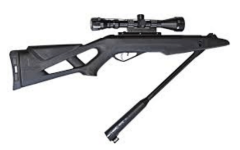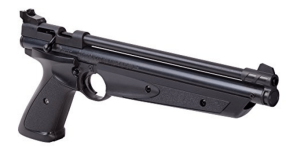I get raccoons and possums in my back yard. I am a live-and-let-live guy, but I do know that sometimes they carry serious diseases, and I may sometimes need to dispose of a violent visitor. I live just close enough to a town that it would cause me serious issues with the police if I used a gun, and especially if I used a gun with a noise suppressor without the proper permits.
Oddly, I am completely allowed to legally use an air-rifle, so I researched them. Accuracy at ten yards (32 ft, 10 meters) is easily achieved across my back yard with the most affordable types, but I couldn't help but to be curious.
The most popular beginner style is a top break rifle (or pistol). The stock and barrel fold across a central hinge, and doing this single motion will set a spring-loaded piston.

Crosman popularized the style where the forestock is the handle for an air-pump. This also means that you can choose how much pressure is stored in the reservoir by how many pumps you put into it (the lower "barrel" is a gas cylinder).

The next step up is PCP / "pre-charged pneumatic". This style has an on-board tank that can hold pressurised air. The compressor is separate. Since the tank on the rifle is small, shooters can sometimes carry a larger tank to replenish the rifle. A popular "belt-tank" is a used carbon fiber unit that has been decommissioned from a firefighter air-mask. They are replaced on a regular basis, and the old ones sold.
There are three major divisions. First is unregulated (less expensive), then Mechanical regulator, and last the electronically-controlled regulator. My preference is a mechanical regulator, as I don't like batteries and electronics in a rifle.
Unregulated means there is a single pressure cylinder, and as the pressure goes down from one shot to the next, the bullets shoot slower. Incidentally, the highest pressures to not yield the fastest or most accurate shots. The striker that opens the spring-loaded air-valve can't open it all of the way when the pressure is at the tanks highest setting (since the tank pressure is pushing back against the valve). High pressure in an unregulated PCP just means you can get a lot of shots before needing to refill.
The next two types have two reservoirs in the rifle. The large storage reservoir is charged up as high as possible, and the adjustable regulator then sends some of the pressure that you desire into the shooting reservoir. The trigger mechanism opens the shooting reservoir pressure into the breech to propel the pellet. Since the small shooting reservoir is always at the same pressure, the accuracy and range of each shot will be more consistent.
The air-pressure regulator can be mechanical or electronically controlled, but either one provides the best possible accuracy in an air rifle. These are more expensive, so the rest of the component set is usually made to a higher level of quality than the average air rifle. The most expensive ones can use 3,000-PSI from a SCUBA compressor, and they use calibers that can be found as cast lead bullets. This allows you to melt and cast your own bullets, if you wish. 177 and 22 are by far the most popular calibers. Due to the blunt shape of the pellets, their velocity drops off fast near the end of their range.
.177 caliber, good for birds, rats, and mice, up to 30 yards
.22, squirrels, rabbits, etc...up to 40 yards
.25, raccoons, possums, etc...up to 50 yards
.30, (at 3,000-PSI)
.357, (at 3,000-PSI) coyotes, wild pigs at 100 yards
.44, .45, .50 (at 3,000-PSI) deer at 100 yards.
If your main interest is in the rifle being quiet, many models have a noise suppressor that is integrated (not removable), and the speed of the pellet should be kept below 900 feet per second (FPS) to avoid breaking the sound barrier.



